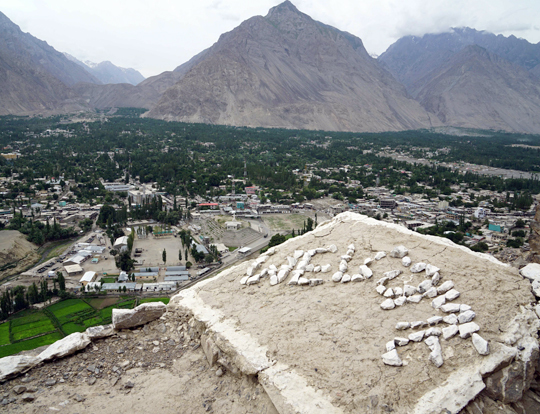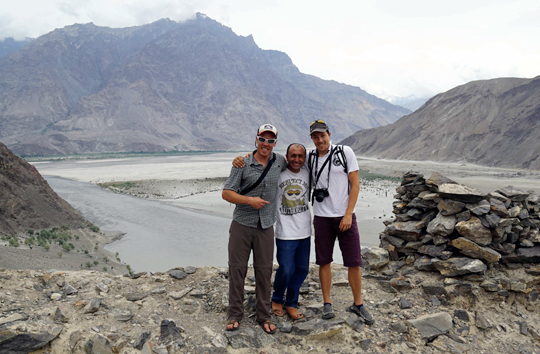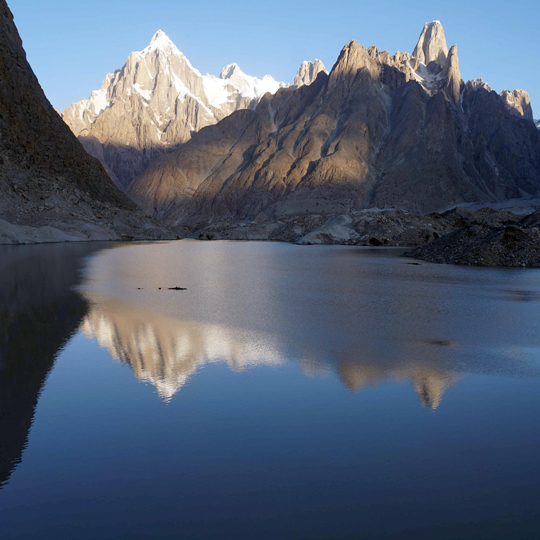Kyle Dempster has seen his share of successes in the Karakoram in recent years, climbing difficult new routes on Hassan Peak (6300m), K7 (6934m) and the Ogre 1 (7285m). He’s also weathered a few failures, depending how you define the word. Last season he and his partners cancelled their trip to the Karakoram to attempt Tahu Rutum (6651m) and Kunyang Chhish East (7431m) in the wake of the terrorist attack on climbers camped in Nanga Parbat’s Diamir Base Camp; in 2008, he spent 24 days alone on the unclimbed west face of Tahu Rutum, bailing 300 meters from the summit.
This year, Dempster returned to the Karakoram with Slovenian Urban Novak and a plan to climb a bold line up the relentless and complex Shining Wall of Gasherbrum IV. GIV has escaped most public attention by falling just 70 meters short of the arbitrary 8000-meter touchstone, Michael Kennedy explained in his 2003 Alpinist Mountain Profile of the peak. “[O]nly a small circle of aficionados understand GIV’s significance, its iconic station in the pantheon of the great mountains of the world.” Since its first ascent was claimed under siege by the Italians in 1958, only a handful of teams have reached anything close to the summit.

So when Dempster’s application for funding rolled in to the inbox of the Mugs Stump Award, an alpine-climbing grant our magazine co-funds that’s focused on fast and light objectives by North American teams, his proposal to attempt a new route on The Shining Wall in alpine style garnered enthusiastic yeses from all seven committee members. Last month, he returned from his trip, not with a fresh routeline to draw to the summit of GIV, but with a good story about making the best of a bad situation.–Ed.
Lofty dreams build like clouds in the minds of climbers. We chase aspirations of high mountaintops, and from each adventure a new layer of personal growth is sown into the collective field of our experience. These fields contribute to the harvest that becomes our being.
Some say the pursuit is as plainly simple as “Go up the mountain, come back down.” But the emotional complexity is far more expansive. We laugh and stand on the mountaintop, we cry and grimace from the pain in the action. Sometimes people die, and we stand there naked, raked to a raw existence and absorbed by the wretched feeling of an abyss that was once full of life and love.
Slovenian climbers Ales Holc and Peter Meznar had been gone from base camp for 13 days. They had left their camp on the Shaksgam river in remote western China, carrying 10 days of food and with hopes of establishing the first ascent of Durbin Kangri II. Their fellow expedition members, and my personal friends, Jesse Mease, Rob Duncan and Bruce Normand had begun working with the Slovenian alpine club, the Slovene embassy to China and Chinese authorities and were requesting a helicopter search for the missing climbers.
Urban Novak and I were in Skardu, Pakistan, gathering last minute supplies for our own expedition to the Choktoi glacier when news of their disappearance reached us via a mediocre wireless connection. I watched as concern and uncertainty swept across Urban’s face, “Ales is a close friend, he was my climbing mentor when I first started.”

It took a few moments, but slowly, and quite selfishly, the realization that our expedition was falling apart rose through my mind and body. It felt as if my heart dropped out of my rear end and landed on the floor. Emotions swirled. In 2005 I watched my cousin fall to his death. The experience changed me forever and for almost a year afterward I wanted nothing to do with climbing.
I summoned the strength, “I am so sorry,” I said to Urban, “let’s stay in town until we find out more details. If you don’t want to climb and feel like you need to go home, I totally understand.”
After a few days it became apparent that Ales Holc and Peter Meznar would not be returning to their families; too many days had passed without word from the climbers. Speculation of their death resulting from an avalanche spread through Slovenia, the US, China and to Urban and I in Pakistan. Urban made plans to go home so he could be with the Slovenian climbing community, offer his support and think about his own relationship with climbing and the death of his two friends, his first experience with the dark side of the sport.

Political corruption, social instability and fragile international relations compromise any climbing trip to Pakistan. This year, my fifth expedition to the country, was chalked so full of bureaucratic hassles prior to leaving that while I continued to fight for access to Pakistan, I did so with the conviction that it might be time to visit and climb in another Himalayan country. Saddened by Urban’s loss, I too could have boarded a plane, less than a week after arriving to Pakistan, and headed home. But we had fought so hard to get here, our visas taking nearly five months to secure. I wasn’t ready to call it quits. My Pakistani friend Ghafoor and I each packed our backpacks with 10 days of food and headed into the Karakoram to take a look at some mountains that I’ve long desired to visit.
There is no place on earth that comes close to the striking intensity of the mountains on the Baltoro glacier, the Throne Room of The Mountain Gods. Under clear skies Ghafoor and I hiked out to Concordia Base Camp, and I stood transfixed under Gasherbrum IV’s Shining Wall, K2 and the immensity of Broad Peak. The next day I soloed up to 6000 meters on Vigne peak to gain a better look around. It was like standing on the far end of a hallway, giants of my imagination and desire lining each side of the corridor. I will return, I must return, I thought to myself.
Even though this expedition was unsuccessful in the context of standing on the summit of a mountain, I do consider the respect and choices that Urban demonstrated concerning the loss of his friends as highly commendable. I believe he made the right choice to go home, a decision that is expressive of his sympathy and compassion for human life and the people that comprise the community to which he belongs. I hope to climb with him in the future.
[We extend our sincere condolences to Novak and the rest of Slovenia’s alpine-climbing community for the difficult losses of Ales Holc and Peter Meznar.–Ed.]

